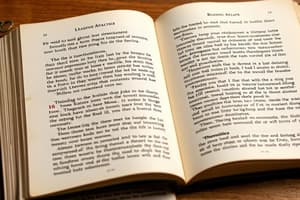Podcast
Questions and Answers
What is the aim of using visual arts in teaching literature?
What is the aim of using visual arts in teaching literature?
Which of the following is NOT considered a form of visual art mentioned in the text?
Which of the following is NOT considered a form of visual art mentioned in the text?
How does the text describe the role of visual arts in promoting literacy among learners?
How does the text describe the role of visual arts in promoting literacy among learners?
What does the text suggest about using visual arts to interact with literature in the classroom?
What does the text suggest about using visual arts to interact with literature in the classroom?
Signup and view all the answers
Why might a literature teacher use visual arts in teaching?
Why might a literature teacher use visual arts in teaching?
Signup and view all the answers
What is the focus of this chapter?
What is the focus of this chapter?
Signup and view all the answers
How does interpreting literature through visual arts benefit children?
How does interpreting literature through visual arts benefit children?
Signup and view all the answers
What does drama and play provide children with, in the context of interpreting literary texts?
What does drama and play provide children with, in the context of interpreting literary texts?
Signup and view all the answers
What is the role of creative writing in interpreting literary texts for children?
What is the role of creative writing in interpreting literary texts for children?
Signup and view all the answers
How can different expressions of meaning be explored in this chapter?
How can different expressions of meaning be explored in this chapter?
Signup and view all the answers
Study Notes
Role of Visual Arts in Teaching Literature
- The aim of using visual arts in teaching literature is to promote literacy among learners.
- Forms of visual arts mentioned in the text include drama, creative writing, and play.
Benefits of Visual Arts in Interpreting Literature
- Interpreting literature through visual arts benefits children by enhancing their understanding and interaction with literary texts.
- Visual arts provide an alternative means of expression, allowing children to engage with literature in a more creative and interactive way.
Functions of Visual Arts in the Classroom
- A literature teacher might use visual arts to facilitate a deeper understanding of literary texts and promote literacy among learners.
- Visual arts enable children to explore different expressions of meaning, fostering a more comprehensive understanding of literary texts.
Focus of the Chapter
- The focus of this chapter is on the role of visual arts in teaching literature and promoting literacy among learners.
Studying That Suits You
Use AI to generate personalized quizzes and flashcards to suit your learning preferences.
Description
Test your knowledge of effective methods to interpret literary texts for and with children. Explore strategies involving visual arts, drama, and creative writing to develop literacy in young learners.




